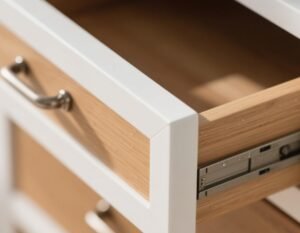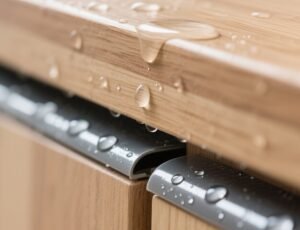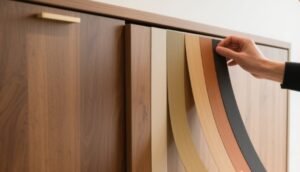Many parents worry about whether the furniture their kids use every day is truly safe — especially the small details like edge banding.
The best edge banding for children’s furniture is soft, non-toxic, and certified safe. Materials like ABS and TPE are commonly used because they offer good durability and meet safety standards.

When it comes to children’s furniture, safety isn’t just a bonus — it’s the foundation. Let’s walk through the main things to look for in edge banding and why certain materials make a big difference.
Why Safety Standards Matter in Edge Banding for Children’s Furniture?
It only takes one sharp edge or one toxic material to put a child at risk — edge banding plays a bigger role than most people think.
Safety standards matter because children’s furniture often takes more abuse, and kids are more sensitive to chemicals and injuries. Edge banding that meets recognized safety certifications protects them from harm.

What Makes Safety So Important?
Children interact with furniture differently than adults. They lean, climb, bite, scratch, and bump into furniture all the time. This means every part of that furniture — including the edges — must be safe and strong. If the edge banding is made of poor materials or installed poorly, it can peel off, break easily, or expose sharp corners.
Key Safety Standards to Look For
| Certification | What It Proves | Region |
|---|---|---|
| EN71-3 | Non-toxic for children | Europe |
| REACH | No harmful chemicals | Europe |
| RoHS | Limits on hazardous substances | Global |
| ASTM F963 | Safety for children’s products | USA |
I always look for suppliers who provide test reports for these standards. If you’re sourcing for export, these certificates aren’t optional — they’re essential.
Key Features to Look for in Kid-Friendly Edge Banding?
Some edge banding looks fine, but it might not be safe. And some safe materials don’t always hold up over time — we need both.
Kid-friendly edge banding should be smooth, soft, durable, odor-free, and resistant to cracking or peeling. It should also be easy to clean and impact-resistant.

What Makes Edge Banding Child-Safe?
Here’s how I break it down when recommending or selecting edge banding for a children’s furniture project:
1. Soft Edges
Furniture edges should not hurt if a child bumps into them. Materials like TPE and soft PVC provide a flexible surface.
2. Impact Resistance
Kids throw toys, jump on furniture, or run into corners. Edge banding should be able to handle all that without cracking or chipping.
3. No Odor or VOCs
Some plastic edge banding releases unpleasant smells or harmful gases. Make sure the material is low-VOC and odorless.
4. Long-Term Adhesion
Edge banding must stay on. Weak glue or thin material peels off easily, which is dangerous for kids who might try to pull it or chew it.
Feature Comparison Table
| Feature | ABS | TPE | PVC |
|---|---|---|---|
| Softness | Medium | Very High | Medium |
| Odor/VOC | Low | Very Low | Medium |
| Impact Resistance | High | Very High | High |
| Price | Medium | High | Low |
| Ideal for Kids? | Yes | Yes | With caution |
Best Edge Banding Materials for Children’s Furniture: ABS, TPE, or PVC?
Not all plastics are the same. When safety and function both matter, choosing the right edge banding material becomes a key decision.
ABS and TPE are generally the best choices for children’s furniture. They are safe, strong, and meet strict environmental standards. PVC is cost-effective but needs to be used carefully.

Which Material Works Best?
ABS: A Balance of Safety and Durability
ABS is widely used in high-end children’s furniture. It’s impact-resistant, stable, and doesn’t produce strong smells. It’s easy to color match, which helps with design.
TPE: The Softest and Safest
TPE is soft, flexible, and often used in rounded furniture designs for toddlers. It’s more expensive, but if safety is the top priority, it’s worth it. It’s also ideal for edge profiles that require a smooth touch.
PVC: Only If It’s Certified
PVC is popular due to its low cost. But I only recommend it if it’s phthalate-free, odorless, and tested for children’s use. Some cheap PVC options contain harmful additives.
When to Choose What?
| Situation | Best Material |
|---|---|
| Nursery furniture | TPE |
| School desks | ABS |
| Budget-conscious projects | Certified PVC |
| Rounded corners | TPE |
| Color customization needed | ABS |
How to Ensure Your Edge Banding Is Non-Toxic and Certified Safe?
Some suppliers promise “eco” or “safe” products — but those words don’t always mean much without proof.
You can ensure edge banding is safe by asking for third-party test reports, checking certification labels, and working only with experienced suppliers.

My Checklist for Safe Sourcing
I’ve seen companies get into trouble simply because they didn’t verify what they were buying. So I follow a fixed process:
1. Ask for Test Reports
Request recent (within 1 year) testing documents — REACH, EN71-3, RoHS, or similar. I prefer reports from SGS, TUV, or Intertek.
2. Confirm Material Composition
For example, true TPE should not contain any PVC. Real ABS should be 100% virgin or recycled ABS, not mixed with cheap fillers.
3. Smell Test and Aging Resistance
Yes, I literally smell the edge banding samples. If the smell is strong or lingers, it’s not suitable for children’s use. I also check if the color or flexibility changes after 7-14 days in a warm, dry environment.
4. Choose the Right Glue
Even with the best edge banding, poor glue can ruin it. Make sure hot-melt adhesives are safe for indoor use and low in VOCs.
| Step | What to Check |
|---|---|
| Certification | EN71-3, REACH, RoHS |
| Source Material | ABS, TPE, Certified PVC |
| Odor/Off-Gassing | No strong smell |
| Third-Party Testing | SGS, TUV, Intertek Reports |
| Adhesive Used | Safe hot-melt, non-toxic |
Real-World Examples of Safe and Durable Edge Banding in Kids’ Furniture?
It’s one thing to talk about materials. It’s another to see how they perform in actual products.
Many leading children’s furniture brands use ABS or TPE edge banding in desks, beds, and storage units — these materials have proven safe and reliable over years of use.

What I’ve Seen in the Market
I worked with a client designing modular study desks for elementary schools. After testing PVC and ABS, they switched to TPE for the corners. The result? Fewer complaints from parents, and after 2 years, the banding still looked new.
Another customer producing storage cabinets for a preschool went with ABS in bright custom colors. It helped the furniture stand out visually while still meeting the European EN71-3 standard.
Example Applications
| Furniture Type | Material Used | Why It Worked |
|---|---|---|
| Toddler Play Tables | TPE | Soft, safe for bumps and bites |
| Preschool Storage Units | ABS | Durable, colorful, and odor-free |
| Budget Cribs | Certified PVC | Met price target with safety label |
| Study Desks | ABS + TPE | Strong core with soft corners |
Seeing these examples helps explain why choosing the right edge banding from the beginning saves time, cost, and risk later on.
Conclusion
Safe edge banding is the starting point, not the afterthought, in children’s furniture. Choose smart, and you protect what matters most.




